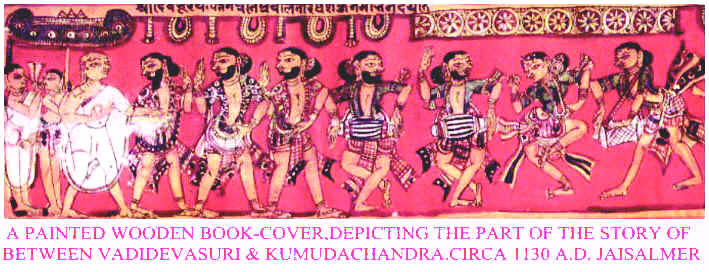Jain Paintings
 |
Historical Background
Eastern & Western Schools of Jain Paintings
A natural question which presents itself is that, though Eastern and Western schools of painting are more or less contemporary at least in their formative stages why such pronounced differences have arisen. The answer to this query is offered by the Tibetan historion Taranatha (1608 A. D.) Giving the history of Indian painting, he says that in the time of the Blessed One the artists were imbued with supernatural power and produced astonishing work of art. He quotes the authority of the Vinayavastu and other works to show that the wall-paintings, etc., of these masters were such as to deceive people by their likeness to the actual objects depicted. The tradition of these masters lasted for some centuries after the Nirvana of the Buddha. Then the art was taken up by the Devas or the heavenly artists who had adopted human form.
Later on Nagas and Yakshas, the vegetable and water spirits, practiced painting from the time of Asoka to the time of Nagarjuna (70 A. D.) Resuming the history, Taranatha says that the art of the Nagas and Yakshas was forgotton rapidly and a number of provincial schools came into being. In the reign of Buddhapaksha (between 5th and 6th century A. D.) the great painter and sculptor Bimbasara produced great works of art. His works were executed after the style of the Devas. The number of his followers was extremely great, and as he was born in Magadha the artists of his school were styled Madhyadesa artists. Another school which is named ancient school of the West was founded by Sringadhara of Maru (Marwar) who was an accomplished artist and painter. He worked under Harshavardhana (610-650 A. D.) Two other painters named Dhimana and his son Bitpalo, hailing from Varendra, and who worked in the reign of Devapala and Dharmapala, adopted in their cast-metal works and paintings the ancient style of the Nagas. "The father and son gave rise to different schools; as the son lived in Bengal the cast images of gods produced by their followers were called the gods of the Eastern style, whatever might be the birthplace of their actual designers. In paintings, the followers of the father were called the eastern school; those of the son, as they were most numerous in Magadha, were called the followers of the Madhyadesa school of painting. So, in Nepal, the earlier school of art resembled the old Western school, but in the course of time a peculiar Nepalese school formed itself which in painting and casting resembled rather the Eastern school, the latest artists have no special character. In Kashmir too there were in former times followers of the old Western school of Madhyadesa; later on a certain Hasuraja founded a new school in painting and sculpture, which is now called Kashmir school. Wherever Buddhism prevailed, skilful artists were found, while wherever the Mlechhas ruled, they disappeared; where again the Tirthya doctrines (orthodox Hinduism) prevailed unskilful artists came to the front."
-----------------------------------------------------
From : Jain Paintings By Shri S. M. Nawab
-----------------------------------------------------
Mail to : Ahimsa Foundation
www.jainsamaj.org
R150203